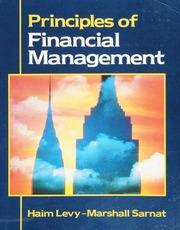Answered step by step
Verified Expert Solution
Question
1 Approved Answer
Excuse me where can I find the solution Question 2 (25 marks/Bond Valuation) David Palmer identified the following bonds for investment: Bond A: A $1

Excuse me where can I find the solution
Question 2 (25 marks/Bond Valuation) David Palmer identified the following bonds for investment: Bond A: A $1 million par, 10% annual coupon bond, which will mature on July 1, 2025. 1) 2) Bond B: A $1 million par, 14% semi-annual coupon bond (interest will be paid on January 1 and July 1 each year), which will mature on July 1, 2031. 3) Bond C: A $1 million par, 10% quarterly coupon bond (interest will be paid on January 1, April 1, July 1, and October 1 each year), which will mature on July 1, 2026. The three bonds were issued on July 1, 2011. (Each Part is Independent) If Bond B is issued at face value and both Bond B and Bond A are having the same yield to maturity (EAR), calculate the market price of Bond A on July 1, 2011. [Note: Full mark would only be given to correct answer of which the values of those variables not provided in the question directly are derived.] (a) (6 marks) (b) David purchased the Bond C on January 1, 2014 when Bond C was priced to have a yield to maturity (EAR) of 10.3812891%. David subsequently sold Bond C on January 1, 2016 when it was priced to have a yield to maturity (EAR) of 12.550881%. Assume all interests received were reinvested to earn a rate of return of 3% per quarter (from another investment account), calculate the current yield, capital gain yield and the 2-year total rate of return (HPY) on investment for David on January 1, 2016. [Hint: Be careful with how many rounds of coupons has David received during the holding period and thus how much interests (coupons and reinvestment of coupons) he has earned in total during the 2-year holding period.] (14 marks) (c) David purchased Bond B on a coupon payment day. Bond B is priced to have a yield to maturity (EAR) of 12.36% and its market value is $1,101,058.953 on the date of purchase. Find the remaining life until maturity (in terms of 6-month period or year) of Bond B. (5 marks) Question 2 (25 marks/Bond Valuation) David Palmer identified the following bonds for investment: Bond A: A $1 million par, 10% annual coupon bond, which will mature on July 1, 2025. 1) 2) Bond B: A $1 million par, 14% semi-annual coupon bond (interest will be paid on January 1 and July 1 each year), which will mature on July 1, 2031. 3) Bond C: A $1 million par, 10% quarterly coupon bond (interest will be paid on January 1, April 1, July 1, and October 1 each year), which will mature on July 1, 2026. The three bonds were issued on July 1, 2011. (Each Part is Independent) If Bond B is issued at face value and both Bond B and Bond A are having the same yield to maturity (EAR), calculate the market price of Bond A on July 1, 2011. [Note: Full mark would only be given to correct answer of which the values of those variables not provided in the question directly are derived.] (a) (6 marks) (b) David purchased the Bond C on January 1, 2014 when Bond C was priced to have a yield to maturity (EAR) of 10.3812891%. David subsequently sold Bond C on January 1, 2016 when it was priced to have a yield to maturity (EAR) of 12.550881%. Assume all interests received were reinvested to earn a rate of return of 3% per quarter (from another investment account), calculate the current yield, capital gain yield and the 2-year total rate of return (HPY) on investment for David on January 1, 2016. [Hint: Be careful with how many rounds of coupons has David received during the holding period and thus how much interests (coupons and reinvestment of coupons) he has earned in total during the 2-year holding period.] (14 marks) (c) David purchased Bond B on a coupon payment day. Bond B is priced to have a yield to maturity (EAR) of 12.36% and its market value is $1,101,058.953 on the date of purchase. Find the remaining life until maturity (in terms of 6-month period or year) of Bond BStep by Step Solution
There are 3 Steps involved in it
Step: 1

Get Instant Access to Expert-Tailored Solutions
See step-by-step solutions with expert insights and AI powered tools for academic success
Step: 2

Step: 3

Ace Your Homework with AI
Get the answers you need in no time with our AI-driven, step-by-step assistance
Get Started


